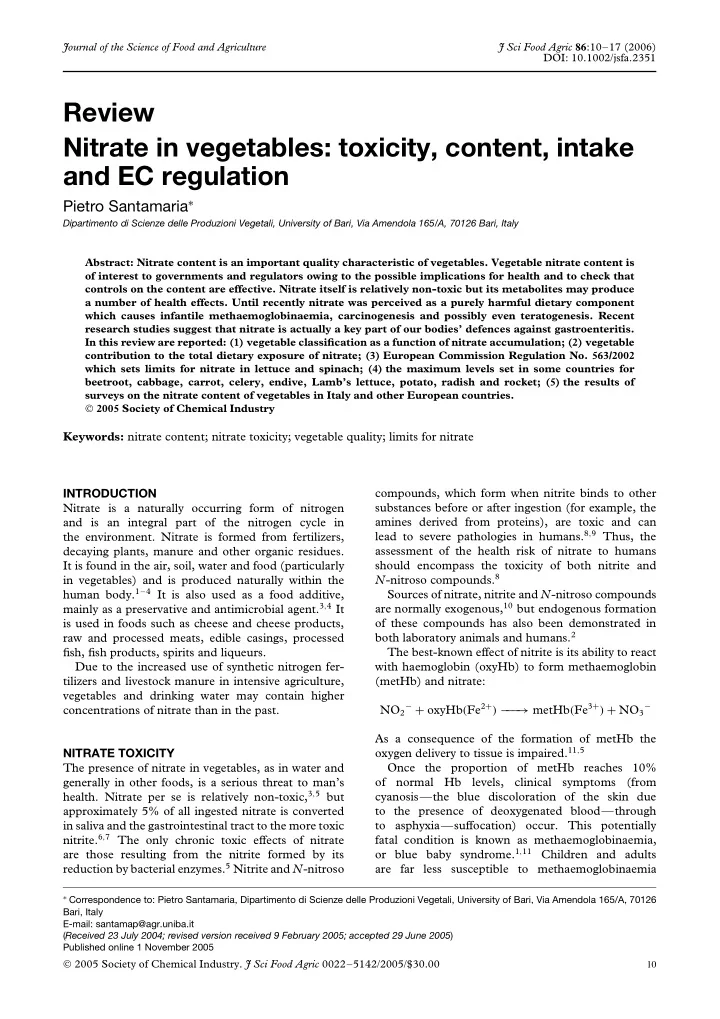

Journal of the Science of Food and Agriculture J Sci Food Agric 86 :10–17 (2006) DOI: 10.1002/jsfa.2351 Review Nitrate in vegetables: toxicity, content, intake and EC regulation Pietro Santamaria ∗ Dipartimento di Scienze delle Produzioni Vegetali, University of Bari, Via Amendola 165/A, 70126 Bari, Italy Abstract: Nitrate content is an important quality characteristic of vegetables. Vegetable nitrate content is of interest to governments and regulators owing to the possible implications for health and to check that controls on the content are effective. Nitrate itself is relatively non-toxic but its metabolites may produce a number of health effects. Until recently nitrate was perceived as a purely harmful dietary component which causes infantile methaemoglobinaemia, carcinogenesis and possibly even teratogenesis. Recent research studies suggest that nitrate is actually a key part of our bodies’ defences against gastroenteritis. In this review are reported: (1) vegetable classification as a function of nitrate accumulation; (2) vegetable contribution to the total dietary exposure of nitrate; (3) European Commission Regulation No. 563/2002 which sets limits for nitrate in lettuce and spinach; (4) the maximum levels set in some countries for beetroot, cabbage, carrot, celery, endive, Lamb’s lettuce, potato, radish and rocket; (5) the results of surveys on the nitrate content of vegetables in Italy and other European countries. 2005 Society of Chemical Industry Keywords: nitrate content; nitrate toxicity; vegetable quality; limits for nitrate INTRODUCTION compounds, which form when nitrite binds to other substances before or after ingestion (for example, the Nitrate is a naturally occurring form of nitrogen and is an integral part of the nitrogen cycle in amines derived from proteins), are toxic and can lead to severe pathologies in humans. 8 , 9 Thus, the the environment. Nitrate is formed from fertilizers, decaying plants, manure and other organic residues. assessment of the health risk of nitrate to humans It is found in the air, soil, water and food (particularly should encompass the toxicity of both nitrite and N -nitroso compounds. 8 in vegetables) and is produced naturally within the human body. 1–4 It is also used as a food additive, Sources of nitrate, nitrite and N -nitroso compounds mainly as a preservative and antimicrobial agent. 3 , 4 It are normally exogenous, 10 but endogenous formation is used in foods such as cheese and cheese products, of these compounds has also been demonstrated in both laboratory animals and humans. 2 raw and processed meats, edible casings, processed fish, fish products, spirits and liqueurs. The best-known effect of nitrite is its ability to react Due to the increased use of synthetic nitrogen fer- with haemoglobin (oxyHb) to form methaemoglobin tilizers and livestock manure in intensive agriculture, (metHb) and nitrate: vegetables and drinking water may contain higher − + oxyHb ( Fe 2 + ) − → metHb ( Fe 3 + ) + NO 3 − concentrations of nitrate than in the past. NO 2 − − As a consequence of the formation of metHb the oxygen delivery to tissue is impaired. 11 , 5 NITRATE TOXICITY The presence of nitrate in vegetables, as in water and Once the proportion of metHb reaches 10% generally in other foods, is a serious threat to man’s of normal Hb levels, clinical symptoms (from health. Nitrate per se is relatively non-toxic, 3 , 5 but cyanosis—the blue discoloration of the skin due approximately 5% of all ingested nitrate is converted to the presence of deoxygenated blood—through in saliva and the gastrointestinal tract to the more toxic to asphyxia—suffocation) occur. This potentially nitrite. 6 , 7 The only chronic toxic effects of nitrate fatal condition is known as methaemoglobinaemia, or blue baby syndrome. 1 , 11 Children and adults are those resulting from the nitrite formed by its reduction by bacterial enzymes. 5 Nitrite and N -nitroso are far less susceptible to methaemoglobinaemia ∗ Correspondence to: Pietro Santamaria, Dipartimento di Scienze delle Produzioni Vegetali, University of Bari, Via Amendola 165/A, 70126 Bari, Italy E-mail: santamap@agr.uniba.it ( Received 23 July 2004; revised version received 9 February 2005; accepted 29 June 2005 ) Published online 1 November 2005 2005 Society of Chemical Industry. J Sci Food Agric 0022–5142/2005/$30.00 10
Recommend
More recommend